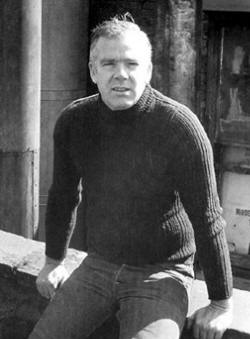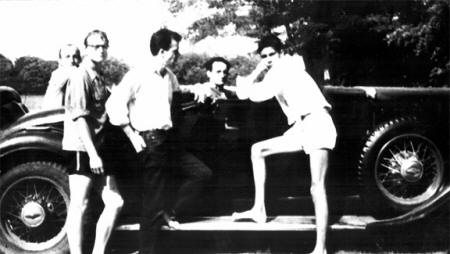

Queer Places:
1355 3rd Ave, San Francisco, CA 94122
University of
California, 110 Sproul Hall, Berkeley, CA 94720
 John Button (March
1, 1929 – December 12, 1982)[1] was an American artist, well known for his city-scapes.[1][2] Educated at the University of California, Berkeley then moved to New York City in the early 1950s. He became friends with
Fairfield Porter and
Frank O'Hara and assumed his part in the New York School of Painters and Poets.
At one point Button was in a relationship with the poet
James Schuyler. Amidst the frenzy of Abstract Expressionism, Button remained true to his interest in realism, and is now most commonly associated with such New York School artists as Fairfield Porter, Jane Freilicher, and Alex Katz. Button was a fine draftsman and drew from life models throughout his career. However, little known are his sketches of male nudes – studio models from the School of Visual Arts, where Button taught, as well as personal acquaintances. Button died of a heart attack in New York City on 12 December 1982.[1]
John Button (March
1, 1929 – December 12, 1982)[1] was an American artist, well known for his city-scapes.[1][2] Educated at the University of California, Berkeley then moved to New York City in the early 1950s. He became friends with
Fairfield Porter and
Frank O'Hara and assumed his part in the New York School of Painters and Poets.
At one point Button was in a relationship with the poet
James Schuyler. Amidst the frenzy of Abstract Expressionism, Button remained true to his interest in realism, and is now most commonly associated with such New York School artists as Fairfield Porter, Jane Freilicher, and Alex Katz. Button was a fine draftsman and drew from life models throughout his career. However, little known are his sketches of male nudes – studio models from the School of Visual Arts, where Button taught, as well as personal acquaintances. Button died of a heart attack in New York City on 12 December 1982.[1]
After John Button's death John Russel wrote the following for Art in Review: When John Button died of heart disease at the age of 53 in 1982, New York City lost one of the painters who was best able to portray it in terms of an unemphatic but penetrating poetry. He could do other places, too —among them Philadelphia, Paris, Venice and Hollywood, not to mention the Redwood National Park in California — but what he prized above all was the moment at which, as he once wrote, "after a dip, the road leaps high into the air on a huge causeway and all of Manhattan comes into view, broadside." But it is clear from his present show at the Fischbach Gallery that when painting and drawing in New York he did not go out for the big splashy all-incluslve panoramas that often tempt the new arrival. He worked with the Manhattan sky as his accomplice. Whether with the laundered blue of high noon or the strange goings-on at nightfall, that sky was omnipresent In "Con Edison" of 1966, the three tall and slender chimneys take an unwonted sweetness from the sky, as well as an echo of the French tricolor. It was also a characteristic of Button at his best that he could work with just a tiny, sprinkled skyline of apart-ment houses, leaving the sky to do most of the work. But when he came down to street level, as in "Garage Space" of 1963, there was magic in his way of placing a precisely observed and solitary shopper on her way home. No one could tell from most of his paintings that he was one of the funniest people around, and also one of the most variously educated. But even in the pencil drawings that he made in the last months of his life, a special way of seeing manifested itself.

South Hampton circa 1955
Frank O'Hara in the rumbleseat, John Ashbery, John Button, Larry Rivers at the wheel, Joe Rivers
My published books: